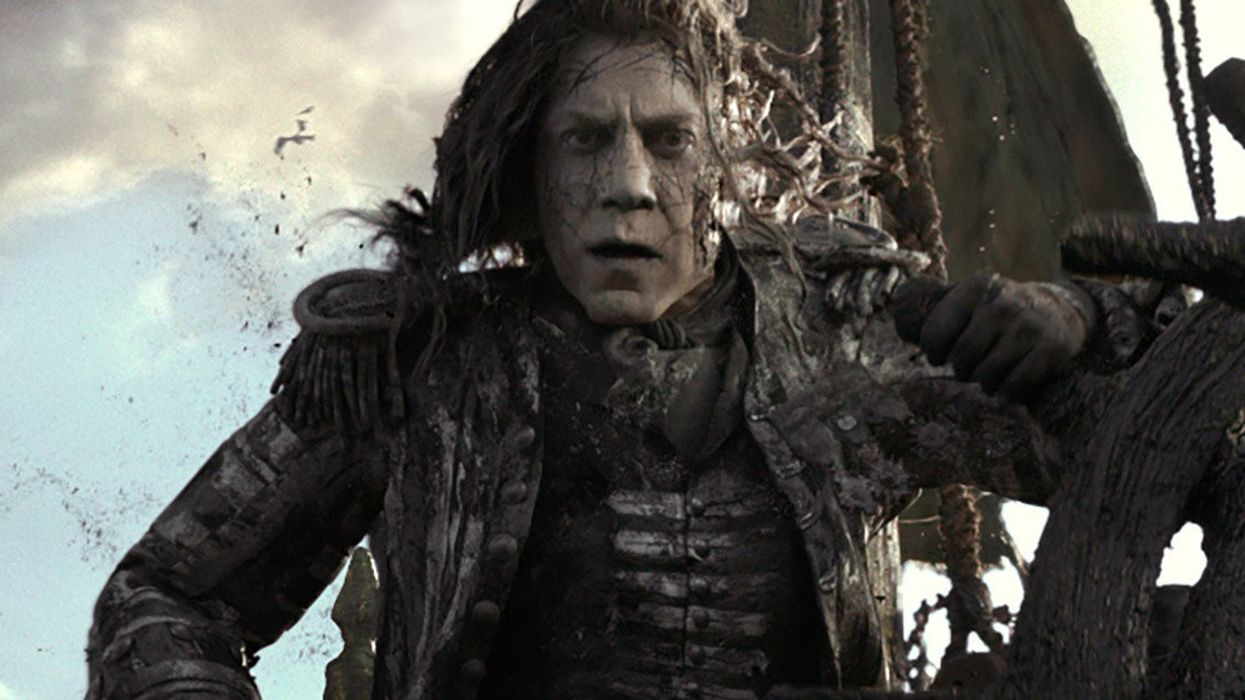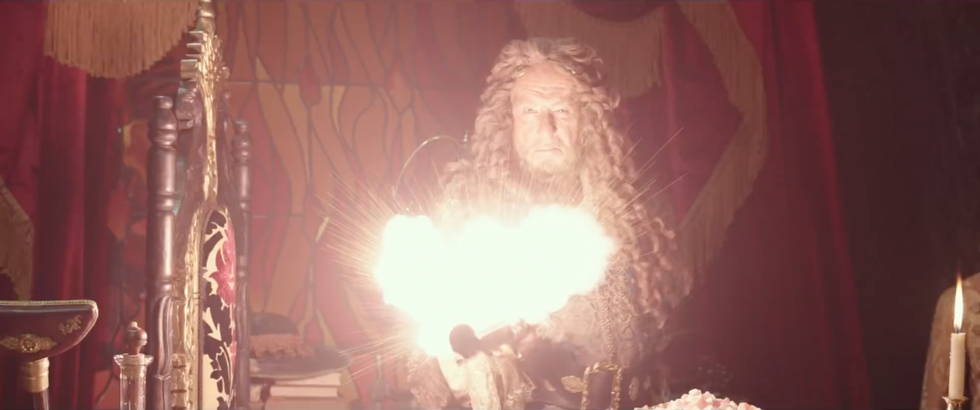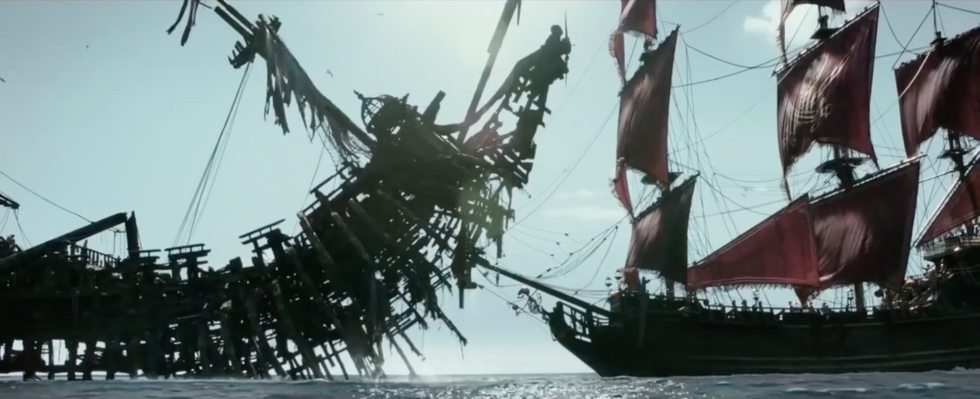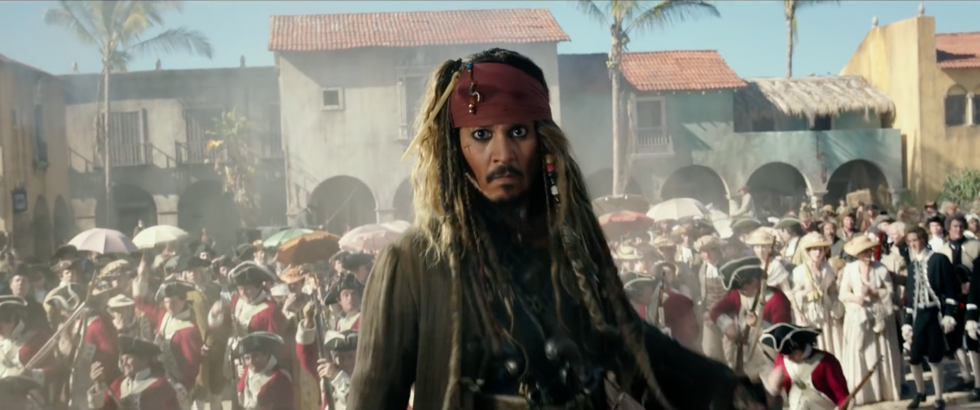How 'Pirates of the Caribbean' DP Pulled Off 'Fast Camera Movement in Challenging Scenarios'
With 'Dead Men Tell No Tales,' Paul Cameron, ASC used imaginative techniques to bring his own visual style to a long-running franchise.

The Pirates of the Caribbean franchise has long been one of Disney’s most profitable and critically acclaimed IPs. Spawned from one of the original rides at Disneyland, the franchise has grossed over $3.5 billion worldwide. The lackluster release of the series’ fourth entry put it on ice for a time, but reception to its newest film, Dead Men Tell No Tales, has been considerably better so far.
A key contributor to this rebirth of the franchise is likely an almost entirely new creative team, led by directors Joachim Rønning and Espen Sandberg. Though longtime producer Jerry Bruckheimer remained at the helm, the extensive new additions included changes to nearly every department, including directly behind the camera, where Rønning and Sandberg hired ten-year ASC veteran, Paul Cameron.
Cameron has long had a penchant for shooting action-heavy flicks, cutting his teeth on middle to upper-level Hollywood blockbusters such as Gone in 60 Seconds, Swordfish, and Man on Fire, but his big breakthrough came in 2004 when he worked alongside Dion Beebe on Michael Mann’s Collateral. The film garnered plenty of awards recognition for its cinematography, including a nomination from the ASC itself, thanks in large part to Cameron’s early-adapting and innovative use of HD cameras. Cameron's technological prowess only continued to grow from there, earning him a reputation as one of the most renowned cinematographers in the business. His status has continued to rise over the years as he elevates every project he's involved in, including his most recent work lensing the phenomenal and gorgeous pilot for Westworld.
"I was able to put technocranes on megadecks and throw them around the ship very quickly and enable kind of fast, good camera movement in very challenging scenarios."
Cameron continues to nail working in his favored genre, and his talent remains evident as he utilizes novel technology and battles against a unique set of challenges in the newest entry into the Pirates of the Caribbean franchise. The latest adventure sees Captain Jack Sparrow (Johnny Depp) on the hunt for the trident of Poseidon and once again on the run from an old nemesis, this time in the form of the undead Pirate-hunter, Captain Salazar (Javier Bardem).
No Film School spoke with Cameron before Dead Men Tell No Tales hit theaters, about shooting on massive blue-screens, filling the shoes of Dariusz Wolski, building a customized drone for Pirates, and more.
No Film School: Starting at the top, how did you get involved with Pirates of the Caribbean: Dead Men Tell No Tales?
Paul Cameron: I heard about the project through some contacts over at Jerry Bruckheimer, and I met Joachim Rønning and Espen Sandberg shortly after and they made an offer within a couple weeks, and we decided to go off and do it together.
At that time, we actually engaged in pre-production with the idea of shooting most of the film in Puerto Rico down in the water and then the film took a slight holiday. Basically, the film was on a vacation for a year after The Lone Ranger came out and the film got kind of re-thought about in terms of approach. I think during that time Joachim and Espen decided that they could work a lot better if we were in more of a green-screen/blue-screen scenario for a lot of the big stuff, so the film got revamped to shoot down in the Gold Coast at Warner Bros. Studios in South Brisbane in Australia where it became predominantly a blue-screen film.

NFS: How involved were you in that choice to move to blue-screen?
Cameron: When I originally signed onto the project, I was very interested in the idea of more photography at open sea. I know it’s a challenge shooting on boats, but I spent a lot of time working on fishing boats when I was young, so I was kind of aware of the challenges. I’ve shot plenty of boats, so you know when it gets retooled more as a blue-screen film it just became a different set of challenges for me. A rethink, but it was challenging coming up with and designing two blue-screen arenas the size of an IKEA building and having it manufactured off a golf course near the studio.
NFS: Did you guys get to shoot on the water at all?
Cameron: We shot about three or four scenes on the water, and that was it.
"There was this kind of, 'Do what you want, this is a new episode of the franchise,' but there was also the reality of, 'This is a franchise.'"
NFS: When you signed on for Dead Men Tell No Tales, you joined a franchise with a look already established by Dariusz Wolski. What was it like to follow in his footsteps, and how did you try to make your work stand out while inheriting Wolski’s vision?
Cameron: Well Dariusz is an amazing cinematographer, and he’s done a brilliant job with the Pirates franchise and on his films with Tim Burton and Ridley Scott, so it was a bit daunting. There was this kind of "do what you want, this is a new episode of the franchise", but there was also the reality of "this is a franchise."
I think by nature I kind of lit and did things the way that I intuitively wanted to do it and there’s some similarities in looks and color-wise just because of the nature of pirates and candle-lit scenes and ships and moonlight, and there is a kind of a visual thread that crosses over. I think for me it was more about my own style of camera movement and lighting that sets me apart from Dariusz a little bit.

Cameron: It wasn’t an attempt to redo a look, whatsoever; it was kind of daunting and a pleasure to come up with a look as good or better than Dariusz’s amazing work on the previous four. So, yeah it did shock me at first that, wait a minute, I guess it is like going on a [television] series a bit. But I think Dariusz and I had a lot of similar styles, and certainly, when it comes to Dariusz’s cinematography, we’ve kind of grown up in the same group of directors and crossed over quite a bit, so it felt very natural, and I’m just thankful that he shot some beautiful movies.
NFS: Some of the early footage released as promotion for the film felt highly reminiscent of the first movie. Were there ever moments meant as conscious visual allusions to Curse of the Black Pearl?
Cameron: No, I think by nature of the material itself, as you can imagine those are big visual effects shots, with a lot of elements shot on bluescreen arenas. There is something linear and cohesive about all of the Pirates movies, so I think it’s just by the nature of it being part of the franchise.
NFS: You helped out with the ASC Master Classes at one point, and you made a point to share a piece of advice from Tony Scott with your students: make yourself interesting and interested in the work. How did you do that on this project?
Cameron: I was very interested in the prospect of doing another big movie specifically with Jerry Bruckheimer and Disney and kind of taking the visual baton for carrying on and creating a slightly enhanced look for Pirates. I think what I brought to the table and how I made it interesting is again, between my own lighting style and camera movement style, along with Joachim and Espen, it was trying to kind of enhance and make this film more fun than other films.
More specifically, I was able to put technocranes on megadecks and throw them around the ship very quickly and enable fast camera movement in very challenging scenarios.

Cameron: The other way I think I brought a level to this one, in particular, was I had a drone manufactured with a company called XM2 for an ALEXA XT. With the restrictions in the United States and in other countries, you can’t fly the ship and camera over 44 pounds, and I found out in Australia that actually you can fly up to 65 pounds or something like that. So I contacted the company and fast-tracked the production on it and got them to fly an ALEXA XT.
You’ll see a lot of shots in Pirates where the camera is kind of going around or hovering around the outside of the ship, and if you look at some of the shots more closely it’s a ship that’s 160-170ft long, and practically, the camera moves were a couple hundred feet within one shot. So technically, it would’ve been possible, but almost impossible to do with a 100-foot techno or 50-foot techno on steel decks. So I think you look at some of these shots and they look like the camera is just kind of going around, but it’s actually a 200-300 foot drone move around the ship, which is something I brought to the party that nobody else had in previous films.










![Ethos, Pathos, Logos: 20 Effective Ways to Advertise [Infographic]](https://nofilmschool.com/media-library/ethos-pathos-logos-20-effective-ways-to-advertise-infographic.jpg?id=34064614&width=600&height=600&quality=90&coordinates=560%2C0%2C0%2C0)

